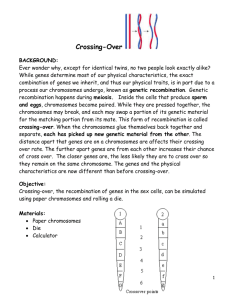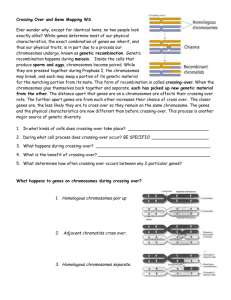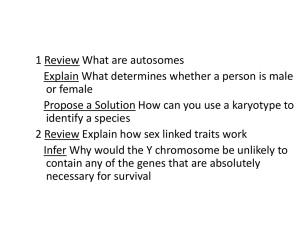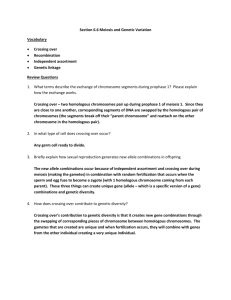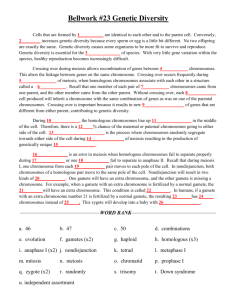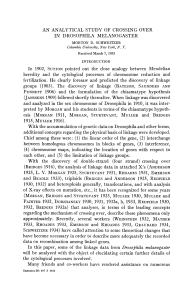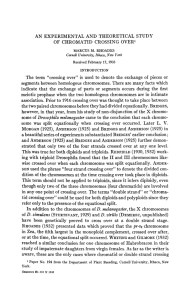Genetics _Activity - Crossing Over Lab
advertisement
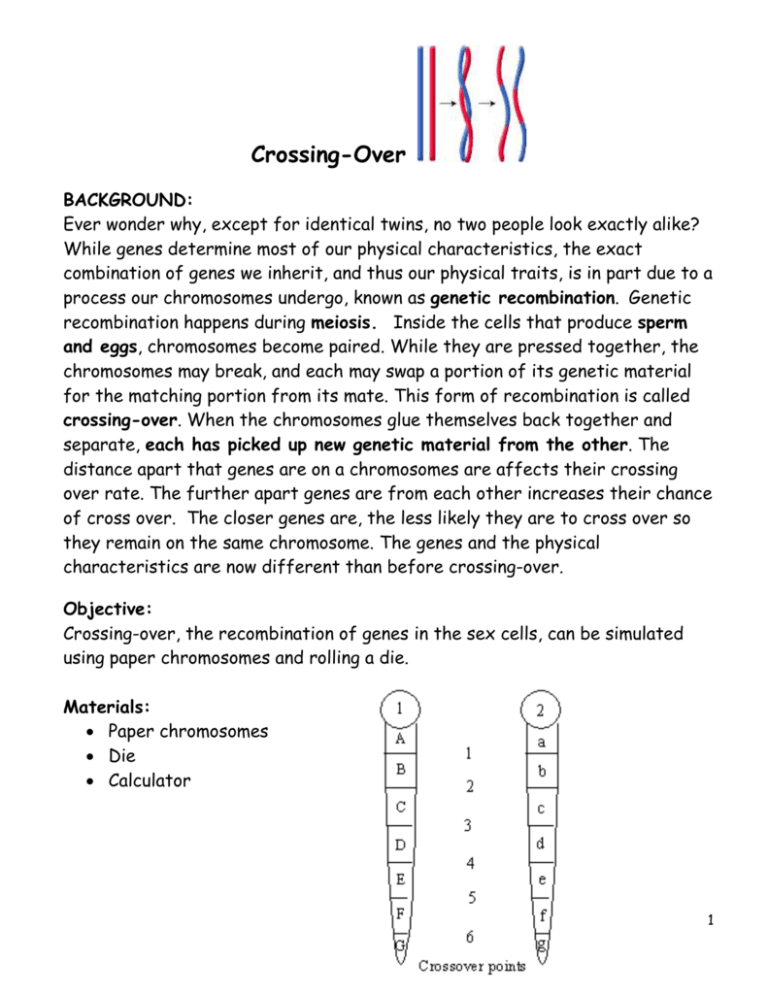
Crossing-Over BACKGROUND: Ever wonder why, except for identical twins, no two people look exactly alike? While genes determine most of our physical characteristics, the exact combination of genes we inherit, and thus our physical traits, is in part due to a process our chromosomes undergo, known as genetic recombination. Genetic recombination happens during meiosis. Inside the cells that produce sperm and eggs, chromosomes become paired. While they are pressed together, the chromosomes may break, and each may swap a portion of its genetic material for the matching portion from its mate. This form of recombination is called crossing-over. When the chromosomes glue themselves back together and separate, each has picked up new genetic material from the other. The distance apart that genes are on a chromosomes are affects their crossing over rate. The further apart genes are from each other increases their chance of cross over. The closer genes are, the less likely they are to cross over so they remain on the same chromosome. The genes and the physical characteristics are now different than before crossing-over. Objective: Crossing-over, the recombination of genes in the sex cells, can be simulated using paper chromosomes and rolling a die. Materials: Paper chromosomes Die Calculator 1 Procedure: 1. Imagine a Fruit fly contains a pair of chromosomes as shown. The Fruit fly is heterozygous for each of seven traits, a through g, found on each chromosome. 2. In the figure, the numbers 1 through 6 indicate points where crossing over may occur, thus separating the alleles. For example, if a cross over occurred at point 3, the alleles on chromosome 1 would be ABCdefg, while those on chromosome 2 would be abcDEFG. 3. Roll the die to randomly determine where a cross over will occur. Note the alleles that would remain on the same chromosome as 'a' and record the data in the chart. 4. Repeat step 3 another 99 times (100 cross-overs total) 5. Calculate the percentage of times each allele is found on the same chromosome as "a". DATA TABLE # of times "a" is on the same chromosome as: % of times "a" is on the same chromosome as: b b c c d d e e f f g g 2 Questions 1. Is the location of crossing over random or does it occur more frequently in any particular location? 2. Which recessive allele most often remains on the same chromosome as "a"? 3. Which recessive allele is most often separated from "a"? 4. Assume a crossover occurs at point 2. What would be the resulting order of alleles on each chromosome? 5. If a cross-over occurred at chiasmata #4, what would be the genes sequence for chromosome #1? 6. Crossing over occurs in what type of cells? 7. How does crossing-over cause genetic recombination? 3 4 Crossing Over Lab Write Up Remember to skip ONE line between sections. Don’t write on back! Don’t use personal pronouns --- I, me, we, she, he, etc. Introduction Include these points in your paragraphs: What is meiosis What type of cells use meiosis Briefly describe the process and results What is crossing over When does it occur What is the result of crossing over Hypothesis Use the statement written on your lab as the objective. Materials Begin your sentence, “The materials used in this lab include…” and then write each item you used separated with commas. Procedure Number and write the steps as they appear on your lab sheet. Results FIRST, draw the data table and fill it in as you do the lab. NEXT, number, write, and underline each question. Answer the questions when you complete the lab. Conclusion Include these things in this order in your paragraphs: Restate your hypothesis Use the FIRST sentence on step 3, BUT include the number of times the die was rolled (100) and the fact that you recorded these 100 rolls. Use the sentence on step 6 to explain how you calculate the % of times “a” was on the same chromosome as “b, c, d, e, f, and g”. NOW THE MOST IMPORTANT PART --- INCLUDING SUPPORTING DATA> o List the sites where crossing over occurred most often and GIVE SUPPORTING DATA for this. o Tell which recessive allele appeared MOST OFTEN with “a” and give the supporting data for this. o Make a concluding statement about crossing over based on what your data shows. (RE-READ LAB BACKGROUND) 5
